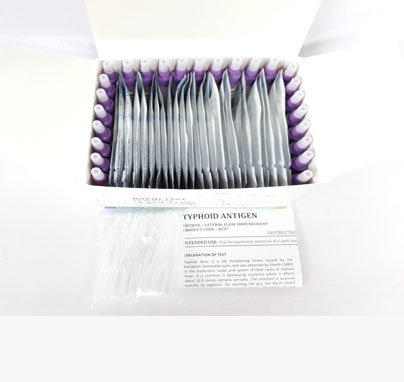SALMONELLA ANTIGEN CARD
Intended Use:
Test for qualitative detection of S. typhi and S. paratyphi antigens in human faeces and serum samples
Introduction:
Typhoid fever is a life threatening illness caused by the bacterium Salmonella typhi, and was observed by Eberth (1880) in the mesenteric nodes and spleen of fatal cases of typhoid fever. It is common in developing countries where it affects about 12.5 million persons annually. The infection is acquired typically by ingestion. On reaching the gut, the bacilli attach themselves to the epithelial cells of the intestinal villi and penetrate to the lamina and submucosa. They are then phagocytosed there by polymorphs and macrophages. The ability to resist intracellular killing and to multiply within these cells is a measure of their virulence. They enter the mesenteric lymph nodes, where they multiply and, via the thoracic duct, enter the blood stream. A transient bacteremia follows, during which the bacilli are seeded in the liver, gall bladder, spleen, bone marrow, lymph nodes and kidneys, where further multiplication takes place. Towards the end of the incubation period, there occurs a massive bacteremia from these sites, heralding the onset of the clinical symptoms. The diagnosis of typhoid consists of isolation of the bacilli and the demonstration of antibodies. The isolation of the bacilli is very time consuming and antibody detection is not very specific. Other tests include the Widal reaction. has developed a test that takes only 10-20 minutes and requires only a small quantity of stool or one drop of serum to perform. It is the easiest and most specific method for detecting S.typhi-S.paratyphi infection.
Salmonella Antigen card

Principal:
S. typhi and paratyphi rapid test is a qualitative immunochromatographic assay. The test employs a combination of monoclonal antibody/colloidal gold dye conjugate and a polyclonal antibody immobilized on the solid phase. This will selectively identify S. typhi and paratyphi antigen associated with typhoid infection with a high degree of sensitivity and specificity. As the specimen flows through the absorbent pad in the sample well and through the antibody/colloidal gold complex any S. typhi and paratyphi antigen present in the sample binds to the conjugate forming an antigen/antibody complex. The sample and dye complex continue to migrate along the membrane to the immobilized monoclonal antibody. In the presence of S. typhi and paratyphi, the monoclonal antibody captures the complex. This forms a visible pink/purple band in the test area of the card. If no antigen is present, there is no line formation. The remaining complex continues to migrate to another immobilized antibody on the membrane in the (C) or Control area of the card, and is captured which then forms a band indicating proper performance of the test.
| Pack Sizes | 25 Test. 50 Test |
| Kit components | Test Device. Sample Collection Tube with Buffer. Assay Buffer. Instructions for Use. |
| Test Procedure | Qualitative only |
| Sample Type | Stool or Serum |
| Kit dimensions | 25 test – 75x150x110 mm. 50 test – 75x275x135 mm |
| Approx. weight of kit | 25 test – 150 gms. 50 test – 300 gms |
| Storage Temperature | Room Temperature |
| Shelf life | 24 months |
| Production Capacity | 50 mn tests per annum |
